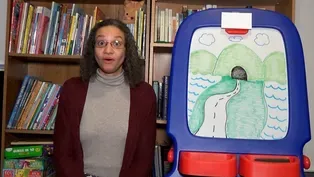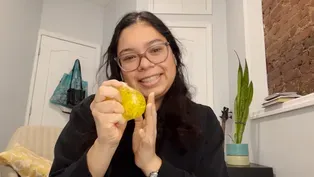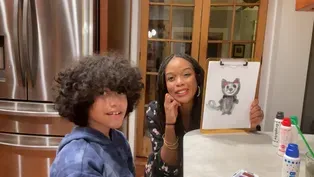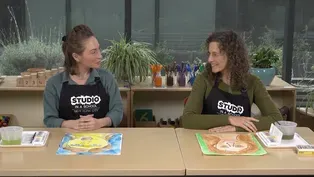
MAKING BREAD
Clip: 5/5/2023 | 10m 7sVideo has Audio Description, Closed Captions
Cassondra Easterling and her children show how to make bread.
Cassondra Easterling and her children show how to combine ingredients to make bread dough. After the dough rises, they knead it, bake, and taste the finished loaf.
See all videos with Audio DescriptionADProblems with Closed Captions? Closed Captioning Feedback
Problems with Closed Captions? Closed Captioning Feedback
Let's Learn is a local public television program presented by THIRTEEN PBS

MAKING BREAD
Clip: 5/5/2023 | 10m 7sVideo has Audio Description, Closed Captions
Cassondra Easterling and her children show how to combine ingredients to make bread dough. After the dough rises, they knead it, bake, and taste the finished loaf.
See all videos with Audio DescriptionADProblems with Closed Captions? Closed Captioning Feedback
How to Watch Let's Learn
Let's Learn is available to stream on pbs.org and the free PBS App, available on iPhone, Apple TV, Android TV, Android smartphones, Amazon Fire TV, Amazon Fire Tablet, Roku, Samsung Smart TV, and Vizio.
Providing Support for PBS.org
Learn Moreabout PBS online sponsorship[upbeat music] - Hi friends!
My name is Cassandra, and these are my helpers.
- Noel.
- And Emerie.
- And we're here today to bring some science into the kitchen.
Today we are going to be learning how we can take some simple ingredients, and transform them into something else, something really delicious that we can eat.
So today we are going to be working with some flour.
Right, here's our flour.
Here's what it looks like.
It's a powder.
Here's the word "flour".
So we're gonna start by using the flour.
And this right here is called yeast.
The yeast will help our bread to rise.
So this is some yeast.
Our yeast needed to be activated depending on what kind of yeast you're using, it might just look like a powder, like our flour.
We'll also be using some sugar, a little bit of sugar, and that's like food for the yeast.
We'll have some salt, and a little bit of warm water.
So Noel and Emerie are going to be helping me to put these ingredients together.
We're gonna mix them up, we'll show you how to knead the ingredients to turn it into some dough, and then we're going to let the dough rise.
And then later we're going to bake the dough and turn it into bread that we can eat.
Are you ready, Noel and Emerie?
- Yeah.
- Yes.
- Are you ready, friends at home?
Let's give it a try.
So we're gonna start with our flour.
Now, Emerie, could you take this bowl of yeast and put it in the flour?
[upbeat music] Good.
Let's use a spoon and get all of it out of there.
Okay.
Now, Noel, could you put the sugar in for us?
Great.
Emerie, how about adding some salt?
[upbeat music] Good job!
And, Noel, how about if you take this water and pour it into our ingredients for us?
[upbeat music] Thank you, Noel.
All right, so let's just take a look at what this looks like right now.
We've got some powdery flour, our yeast is looking pretty bubbly, we've got some water in there.
Now we are going to see how these ingredients transform as Noel and Emerie mix them up, and then knead it.
Okay, so here we go, we've got two spoons.
Can you two mix this up for us?
[upbeat music] Good, you're doing great.
Could I see one of those spoons for a minute?
Thank you.
All right.
So look, friends at home, we're mixing up these ingredients, and we're going to turn it into dough.
We're going to see how the consistency changes.
Look at that!
Look at how it's changing.
Noel and Emerie, look at this.
Do you see how it's changing?
- Yeah.
- Yeah.
- Looks different now.
All right, so let's show our friends at home how to knead their dough.
All right, let's move our spoons over to the side.
We're going to put this on our counter, and we're going to knead it.
You might have to add a little bit of flour to your counter, depending on how sticky your dough is.
Ours looks pretty good, so I'll put it right there.
And, okay, Noel and Emerie, and friends, let's just look at how we knead this.
I'll just move these out of the way.
Okay, so can you watch?
So you're going to use the heels of your hands to press into the dough and fold it over.
And you just keep doing this.
You'll notice that the consistency of the dough will change.
It will seem more elastic, and it won't look dry like this.
Okay?
So we're going to knead it and turn it into our dough for our bread.
Can you try this, Noel?
Try to knead the dough.
Press it, your heels of your hands in.
Yeah, and then fold it over.
[upbeat music] Okay, keep going.
Press your heels in.
Good!
And fold the bread over, now fold it over this way, and press in some more.
Good!
Good job, Noel!
Emerie, do you wanna try it?
- Yeah.
- Good, go ahead.
Knead the bread.
[upbeat music] Good job!
[upbeat music] Good job!
All right.
Can I see it?
You're doing great.
All right, friends at home, so let's take a look at this bread.
This is the dough, the dough for our bread.
Look at how it's changed.
Look at it.
It doesn't look the same anymore at all.
Look at our bread dough.
How did you like kneading it, Noel and Emerie?
- I liked it.
- Doesn't it feel kinda neat?
- Yeah.
- It feels neat, right?
- Yes.
- It feels a little sticky.
[upbeat music] Feels pretty nice.
All right, it's looking pretty good.
All right, so the next step is going to be that we have to let our dough rise.
We are going to put our dough into a bowl, we're gonna put it back into our bowl, we are going to cover it up with a wet cloth.
And then we'll put this bowl over on our oven, so that it's nice and warm, and we'll see if our dough has risen up.
All right, friends, we'll see you again in a little bit.
Our dough has been rising for about 20 minutes, so we're going to check on it now.
Are you ready, Noel and Emerie?
- Yeah.
- Yes.
- You ready to see what it looks like?
Okay, so I'm gonna uncover it.
Oh, wow!
Friends at home, look at it.
Look, how much it's transformed!
So how does it look different, Noel and Emerie?
- It like rised, it's turned bigger.
- It got much bigger.
- They are foamed.
- More formed?
- Yeah.
- Like it's more formed like the shape of the bowl now?
- Yeah.
- Okay.
And do you notice there's lots of little holes in there?
- Yeah.
- Yeah, from the yeast.
Wow!
So friends at home, Noel and Emerie are going to poke it one time, and let's see what happens when you poke the bread one time, the dough?
Can you go ahead?
Poke it.
What happens when you poke your finger into the dough?
- It's like, it feels cool.
- Okay, it feels cool.
- Yeah.
- What do you think, Noel?
- Like the dough like goes back down to like its original form.
- Okay.
So when you poke your finger in it, the indentation stays there.
Can you see that, friends at home?
All right, so now that's our dough.
We're going to transform this again into something yummy that we can eat.
So Noel and Emerie, what is this yummy thing that we're going to be making?
- Bread.
- Yeah.
- That's right.
We're going to transform this now into bread.
So we are going to take this dough.
Oh, wow, it feels so neat.
It's so fun to touch this dough.
We're gonna take the dough out of the bowl, and we're going to put it on our cookie sheet.
And we are going to let this rise a little bit more, and then we'll check on it again, and it will be ready to go into the oven, and we'll turn it into bread.
Our dough is done rising.
Take a look at it, friends at home, see how it transformed.
All right, Noel and Emerie, are you ready?
- Yes.
- Yeah.
- We're going to take our dough and put it in the oven, and turn it into bread, and we'll be able to eat it.
Are you ready?
- Yeah.
- Okay.
So step over here, Noel.
We're gonna take our bread, we're going to put it in the oven, it's going to bake for about 20 minutes.
Can you see it in there, friends at home?
We're gonna check on it in about 20 minutes, and hopefully we'll have some bread to eat.
The timer just went off, I think our bread is ready.
Are you ready to see it?
- Yeah.
- Yes.
- Okay, let's get it out of the oven.
[upbeat music] All right, let me just put the towel down.
All right, here we go.
Look, friends, we made bread.
Okay, let me cut off a piece for Noel and Emerie, now to tell us how we did, okay?
- Okay.
- It is hot though, okay?
So just be careful.
Ooh!
It's so hard to cut.
Did we get it?
[playful music] Okay, here we go.
And let's cut a piece here for each of you.
All right, so here we go.
Here's a piece for you, Noel; and a piece for you, Emerie.
Try it.
Show our friends at home.
How did we do?
- Wow, this is actually so good.
- Is it good?
- Yum.
- It's good?
I'm so proud of you for making bread.
Great job!
Thank you for joining us, friends at home.
- Bye.
- Bye.
- Bye.
ADDING MAGIC E TO WORDS WITH I
Video has Audio Description, Closed Captions
Clip: 5/5/2023 | 8m 16s | Anna Scretching-Cole explains how e at the end of a word can change the vowel sound of i. (8m 16s)
Video has Audio Description, Closed Captions
Clip: 5/5/2023 | 8m 20s | Introducing Spanish words, Brenda Salazar explains how items from her home represent her. (8m 20s)
Video has Audio Description, Closed Captions
Clip: 5/5/2023 | 9m 9s | Shawn Bible’s dance students show how to move in straight, curved, and zig-zag pathways. (9m 9s)
Video has Audio Description, Closed Captions
Clip: 5/5/2023 | 34s | Jewel loves to dance. (34s)
Video has Audio Description, Closed Captions
Clip: 5/5/2023 | 10m 20s | Maria Begg-Roberson reads PERFECT PARTNERS by Mary Amato, illustrated by Kashin Kheiriyeh. (10m 20s)
Video has Audio Description, Closed Captions
Clip: 5/5/2023 | 9m 42s | Katherine Huala and Belinda Blum from Studio in a School create self-portraits. (9m 42s)
Providing Support for PBS.org
Learn Moreabout PBS online sponsorshipSupport for PBS provided by:
Let's Learn is a local public television program presented by THIRTEEN PBS

















